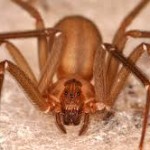 Over the years I have had patients present with skin infections they swore were the result of a spider bite. I am often puzzled by these reports because I can never imagine how a spider would crawl all the way up a persons leg to reach the thigh before inflicting the bite. How can one not feel it while it is crawling that distance? Then, there are others who report the spider bit them in their sleep. I’m sure it’s not impossible, but I find it hard to imagine spiders crawling up into someone’s bed. Not to mention, I am yet to come across someone who actually saw the spider after it inflicted it’s bite.
Over the years I have had patients present with skin infections they swore were the result of a spider bite. I am often puzzled by these reports because I can never imagine how a spider would crawl all the way up a persons leg to reach the thigh before inflicting the bite. How can one not feel it while it is crawling that distance? Then, there are others who report the spider bit them in their sleep. I’m sure it’s not impossible, but I find it hard to imagine spiders crawling up into someone’s bed. Not to mention, I am yet to come across someone who actually saw the spider after it inflicted it’s bite.
Spiders are actually rather harmless for the most part, usually biting people only when threatened. Like many other arthropods, spiders (brown recluse is a big culprit) inject toxin containing venom into the bite wounds of their prey to cause incapacitation, and further, eventual liquefaction of surrounding tissues to facilitate easy ingestion (they are only able to ingest liquid meals through their straw like mouths).
Obviously, this works well on other insects and small animals, but for us humans the main impact of a spider bite is necrosis (death) of tissues surrounding the bite wound. Once healing starts, the inflamed, necrosed area then forms a thick, black scab which eventually falls off. More serious reactions to spider bites are usually due to a severe allergic reaction to components of the venom, sometimes leading to anaphylaxis.
The skin infections that people commonly believe are due to spider bites are in fact, most often due to Staphylococcus aureus (SA) infection. This is not just any SA, but methicillin resistant Staphylococcus aureus (MRSA; for more information on this bug, see here). MRSA acquired in the non-hospital setting (known as community acquired MRSA) almost always produces a toxin called PVL (Panton-Valentine toxin). This toxin, like that in spider venom, causes necrosis of the skin and surrounding tissues, resulting in the same thick, black scab that is seen after venomous spider bites.
Of course, if someone already had MRSA on their skin, it could get introduced into the spider bite wound, subsequently causing infection. In this way, it would seem that the spider itself was the primary cause of the infection, when in fact it was the MRSA.
Though simple MRSA skin infections may heal on their own, often there is significant redness, swelling, pain and pus production and antibiotics are required. Certainly, when there is associated fever, or in persons with other medical problems, medical attention should be sought quickly for the appropriate treatment to be started.
Leave a Reply